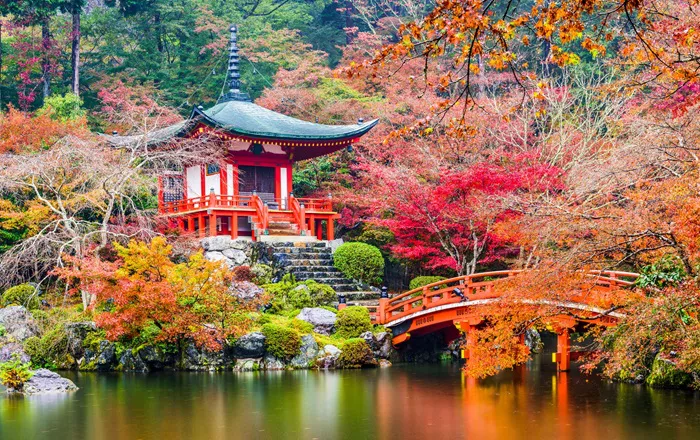Daigo-ji is a famous buddhist temple located in Kyoto, Japan. It is one of the most important temples in the Shingon sect of Japanese Buddhism. Founded in the early 9th century, Daigo-ji holds deep historical and spiritual significance. This temple is known not only for its religious value but also for its beautiful surroundings and ancient temple architecture.
The History of Daigo-ji
Foundation and Early Years
Daigo-ji was founded in 874 by the monk Shōbō, who later became known as Rigen Daishi. The temple was built on the sacred Mount Daigo. At that time, Buddhism was growing strongly in Japan, and Daigo-ji played a key role in spreading the teachings of the Shingon sect. The temple grew quickly and became a center for learning and practice.
Imperial Connection
Daigo-ji was closely linked to the Japanese Imperial family. In the early 12th century, Emperor Daigo, after whom the temple is named, used to visit the temple regularly. The temple became a place of prayer and ritual for the Imperial court. This connection gave Daigo-ji great prestige and helped preserve its cultural heritage.
Periods of Decline and Restoration
Like many old temples, Daigo-ji faced hard times. Fires and wars damaged the buildings several times. However, many efforts were made to restore and protect it. Today, Daigo-ji stands as a symbol of resilience, with many structures preserved or rebuilt following traditional buddhist architecture styles.
Spiritual Significance of Daigo-ji
Role in Shingon Buddhism
Daigo-ji is a major center for the Shingon school of Buddhism. Shingon Buddhism teaches esoteric practices and rituals aimed at enlightenment. The temple serves as a place where monks and followers perform meditation, ceremonies, and study sacred texts. The teachings here emphasize the unity of all things and the possibility of awakening in this lifetime.
Important Religious Events
One of the most famous events at Daigo-ji is the Daigo-ji Cherry Blossom Festival. This event celebrates the fleeting nature of life, a key Buddhist teaching, symbolized by the blooming and falling cherry blossoms. Visitors come to appreciate the beauty and meditate on impermanence.
Relics and Treasures
The temple holds many sacred objects and relics, including ancient statues and scriptures. Some are designated as National Treasures of Japan. These objects help visitors connect with the deep spiritual history of the temple and inspire devotion.
Temple Architecture and Layout
Overview of the Temple Complex
Daigo-ji covers a large area divided into three main parts: the Sambō-in (lower area), the Shimo-daigo (middle area), and the Kami-daigo (upper area). Each section has unique buildings and features. The upper area is located on Mount Daigo, offering beautiful views and a peaceful atmosphere.
Notable Buildings
Five-Story Pagoda
One of Daigo-ji’s most famous structures is its Five-Story Pagoda, built in 951. It is the oldest wooden pagoda in Kyoto and a designated National Treasure. The pagoda’s design reflects classic Japanese temple architecture, with elegant curves and intricate woodwork.
Main Hall (Kondo)
The Main Hall is where important ceremonies take place. It houses a statue of Dainichi Nyorai, the cosmic Buddha central to Shingon Buddhism. The hall’s design is simple but graceful, emphasizing harmony with nature and spiritual focus.
Sambō-in Palace
The Sambō-in area contains a palace built in the Momoyama period. It features beautiful gardens and traditional Japanese architecture. This part of the temple is often visited for its aesthetic beauty and historic atmosphere.
Nature and Surroundings
Mount Daigo and Gardens
The temple sits on Mount Daigo, which is covered with lush forests and walking trails. Many visitors enjoy hiking here while experiencing a peaceful environment ideal for meditation. The temple gardens are carefully maintained and reflect Buddhist ideas about nature and balance.
Seasonal Beauty
Daigo-ji is famous for its seasonal scenery. In spring, cherry blossoms fill the temple grounds, creating a stunning display. In autumn, colorful maple leaves add warmth and depth to the landscape. These natural changes encourage mindfulness of the passing of time and the cycle of life.
Visiting Daigo-ji
How to Get There
Daigo-ji is located in southern Kyoto and is accessible by train and bus. Visitors often take the Tozai Line to Daigo Station, then walk or use a bus service to reach the temple entrance. The upper parts of the temple complex require a hike up the mountain.
What to Expect
Visitors can explore various halls, pagodas, and gardens. There are also small shops selling Buddhist souvenirs and local crafts. Many people come for spiritual reasons, while others visit to appreciate the cultural and historical value of the site.
Recommended Best Time to Visit
The best times to visit are spring and autumn because of the beautiful natural colors. However, Daigo-ji offers something special all year round, including quiet winter walks and fresh summer greenery.
Daigo-ji in Modern Buddhism
Educational Role
Today, Daigo-ji serves as a teaching center. Monks and scholars study Buddhist texts and pass on ancient traditions. The temple holds lectures and retreats open to the public, helping people deepen their understanding of Buddhism.
Preservation Efforts
There are ongoing efforts to preserve the temple’s buildings and artifacts. This work ensures future generations can continue to learn from and enjoy Daigo-ji’s rich heritage. The temple is protected as a UNESCO World Heritage Site, highlighting its global importance.
Conclusion
Daigo-ji is much more than just a historic site. It is a living center of Buddhist practice, culture, and natural beauty. Whether you come for spiritual growth, to admire ancient buddhist architecture, or simply to enjoy peaceful surroundings, Daigo-ji offers a unique experience. Its deep history and connection to Japan’s culture make it a must-visit for anyone interested in Buddhism or Japanese tradition.

